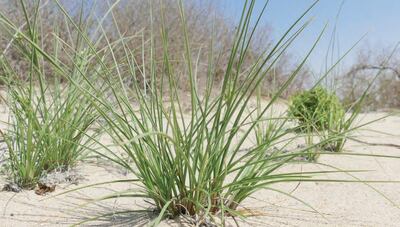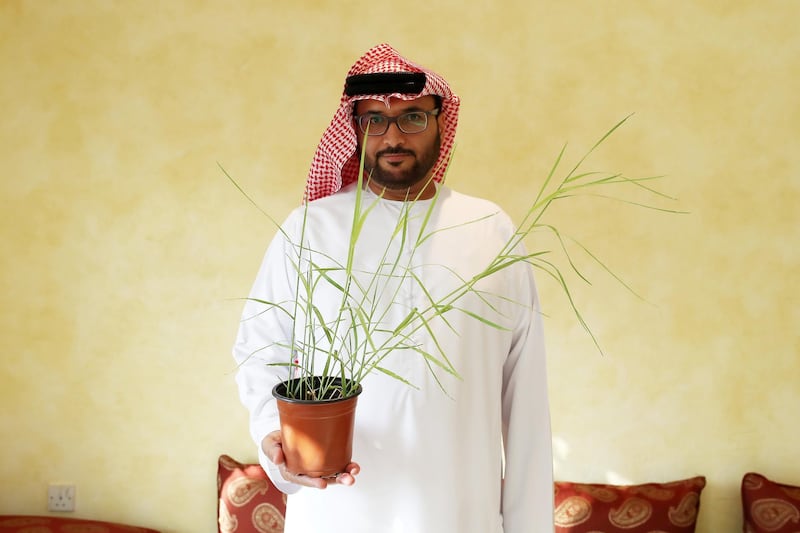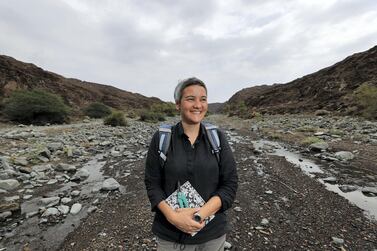Trees may be viewed as the lungs of the planet, but a single blade of grass is the 'foundation for everything'.
That is the view of Mohamed Al Mehairbi, who has spent countless hours painting and identifying grasses that sprout on wadi cliffs and spring from mud flats during his 20 years as a field technician and plant expert for the Environment Agency Abu Dhabi.
Grasses are one of the most diverse plant families, and can survive extreme heat, cold and drought. They thrive in some of the planet’s most unforgiving landscapes, from arctic to Empty Quarter.
Now Mr Al Mehairbi is illustrating its essential role in the ecosystem in a new book, Grasses, sedges and rushes of the UAE, published by the agency this week to mark World Day to Combat Desertification and Drought on June 17.
“Grasses are the foundation for everything,” said Mr Al Mehairbi, who has worked at the agency since 2000. “Before you have trees or shrubs, you have grass.”
The illustrated field guide has descriptions of 84 native and introduced grasses and grass-like species written in simple language for the amateur botanist.
“If you say grass, people only think of two or three species but imagine, in the book we have 82 species and I didn’t even mention there are three more new ones we’ve found,” said Mr Al Mehairbi. “Grasses have a lot of diversity people don’t know about and I want people to understand and appreciate the role of grass.”
Grasses in the Emirates are adapted to a climate that averages about 100mm of rain a year.
Sewan grass (Laiurus scindicus) survives in the interior deserts of the north with a sheath of root hairs and secretions that maximize the uptake of moisture and nutrients.
The bright green sea club (Bolboschoenus maritimus) has a waxy coating to minimize water loss in saline swamps.
The perennial grass Panicum turgidum has narrow leaves to reduce water loss, a common trait of desert plants.
The ability of grass to grow in such extreme conditions has made it essential to human life, said Dr Shaikha Al Dhaheri, the acting secretary general of the EAD.
“It sequesters carbon, reduces soil erosion and stabilises sand dunes,” said Dr Al Dhaheri. “It is also an excellent source of protein that sustains several local wild and domestic grazing species, while grass seeds are a source of nutrition for smaller animals including rodents, hares and birds.
“We hope the information in this book assists policy-makers, researchers, students and the broader community in learning more about one of the most important plant groups in the world and in helping us conserve them.”
Mr Al Mehairbi spends the cooler months doing data collection in the deserts and wadis. When summer temperatures creep into the forties, it is time for data analysis and office work.
With summer here, Mr Al Mehairbi has begun a sequel for the EAD on wildflowers.

Field guides with clear language are important for community engagement, said Marina Tsaliki, a botanist for the Landscape Agency at Ras Al Khaimah Municipality’s Department of Public Works.
“More accessible and understandable data means getting more people involved and aware of the nature around them,” said Ms Tsaliki. “This again helps in raising awareness and sharpening the conscience of everybody alike. This way people also start to care more of what they know, understand and cherish.”
The field guide was released this week because grasses play an important role in fighting desertification.
But in the Emirates, indigenous grasses are at risk because the desert is disappearing.
In the last decade, vast tracks of dunes have been flattened for government housing projects.
“The main thing is loss of habitat,” said Mr Al Mehairbi. “If you go to the northern emirates you’ll see the desert is shrinking slowly, slowly."
Diversity is also threatened by invasive species and overgrazing.
The EAD hopes the book will foster an appreciation for nature and inspire people to use local species in sustainable landscaping.
"People should understand what grass is," Mr Al Mehairbi said. "It's not only a lawn for the garden or for playing football."
Grasses, sedges and rushes of the UAE can be downloaded from the agency's website, www.ead.ae or bought by contacting the agency through its customer happiness email: customerhappiness@ead.ae






